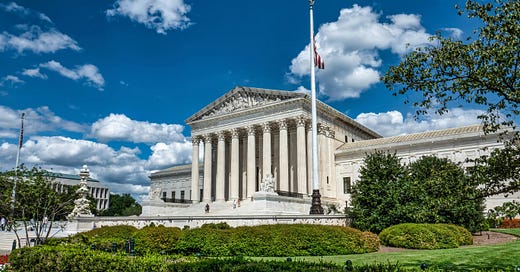Supreme Court gets permitting right in a likely-landmark ruling
Read the mic-drop opinion from Justice Kavanaugh.
Monday rolls around like clockwork! Welcome to June and the official start of the hurricane season. I’m reading The Honest Broker, which provides the data casting doubt on the media’s yearly bout of hysteria that hurricanes will reach disaster-movie proportions. Hurricanes aren’t good, of course, but a dose of realism is in order.
I wrote last week at Independent Women’s Forum about one study that finds no association between renewable energy production and fossil fuel production in 33 fossil fuel states. The full study is paywalled, but the author is a “rural sociologist,” so I’d guess there are grounds to be skeptical of the methods. I also wrote on the President’s four executive orders on nuclear power, which are quite exciting!
Much more exciting, however, is this.
Supreme Court gets permitting right in a likely-landmark ruling
[Last week], the Supreme Court rightsized the scope of National Environmental Policy Act reviews by an 8-0 decision. It could well be a landmark ruling for lower courts because it decides that agencies are not required to study environmental impacts beyond the action’s immediate effects that are under the agency’s regulatory authority.
The case in question, Seven County Infrastructure Coalition v. Eagle County, came about when the Surface Transportation Board granted a petition to construct and operate an 88-mile railway in Utah’s Uinta Basin for transporting crude oil to the national rail network. In 2021, the railway had its environmental impact statements complete. However, Eagle County, Colorado and several environmental organizations contended that the Board omitted “downline impacts” such as increased train traffic on existing rail lines, increased crude oil refining on the Gulf Coast, increased drilling, and potential oil spills along the Colorado River.
To put it simply, it is patently ludicrous to argue that the Surface Transportation Board has the expertise and duty to evaluate climate and greenhouse gas impacts from potential increases in oil drilling caused (somehow) by access to a railroad. The Surface Transportation Board’s original EIS spanned more than 3,600 exhaustive pages. The railroad still hasn’t been built.
The Court heard oral arguments in December 2024 and appeared skeptical of Eagle County’s arguments at the time, with Justice Brett Kavanaugh identifying that “by the courts taking an overly aggressive role it’s, in turn, created an incentive for the agencies to do 3,000 page… environmental impact statements.”
The full opinion, authored by Justice Kavanaugh and joined by Chief Justice Roberts and Justices Alito, Barrett, and Thomas, which is available at the Supreme Court’s website, has some gems that make plain that NEPA is procedural:
Unlike those later-enacted laws [Clean Air Act, Clean Water Act, and Endangered Species Act], NEPA is a purely procedure statute that, as relevant here, simply requires an agency to prepare an EIS [environmental impact statement]—in essence, a report…
NEPA is a procedural cross-check, not a substantive roadblock. The goal of the law is to inform agency decisionmaking, not to paralyze it…
NEPA has transformed from a modest procedural requirement into a blunt and haphazard tool employed by project opponents (who may not always be entirely motivated by concern for the environment) to try to stop or at least slow down new infrastructure and construction projects. Some project opponents have invoked NEPA and sought to enlist the courts in blocking or delaying even those projects that otherwise comply with all relevant substantive environmental laws. Indeed, certain project opponents have relied on NEPA to fight even clean-energy projects—from wind farms to hydroelectric dams, from solar farms to geothermal wells.
The conclusion is equally impressive (kids cooler than I might call it a “mic drop”):
The proper judicial approach for NEPA cases is straightforward: courts should review an agency’s EIS to check that it addresses the environmental effects of the project at hand. The EIS need not address the effects of separate projects…
Citizens may not enlist the federal courts, “under the guise of judicial review” of agency compliance with NEPA, to delay or block agency projects based on the environmental effects of other projects separate from the project at hand.”
Justices Sotomayor, Kagan, and Jackson filed a concurring opinion that agrees with the outcome but argues on the basis of a 2004 ruling, Department of Transportation v. Public Citizen, which holds that agencies need only analyze impacts with “a reasonably close causal relationship” and over which they have “statutory authority” and can prevent. Justice Gorsuch did not take part in the case.
This piece was originally published at Center of the American Experiment on May 29, 2025.






nicely done, thank you. An anecdote for your amusement...
Back in the day, I did several projects for the Surface Transportation Board. They were then, anyway, one of the "good guys" when it came to NEPA. I was preparing an EA for a new rail line that would be used to transport coal. It was a good project - solid economics, few impacts. One of the major benefits to the work was public safety; it would move coal transport from trucks over the local highways to rail, reducing roadway wear and tear and greatly enhancing public safety. But the EPA's position was clear: the EPA would never approve a project that made it easier to mine coal, regardless of its benefits. I understand the STB eventually approved the work (I had retired in the meantime), but it was never constructed. Sad deal...